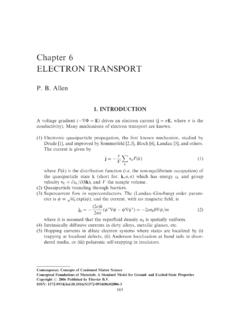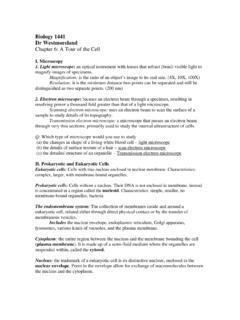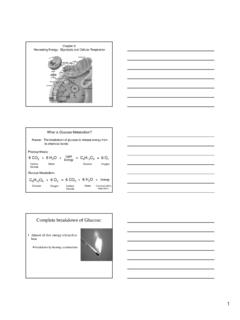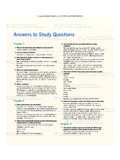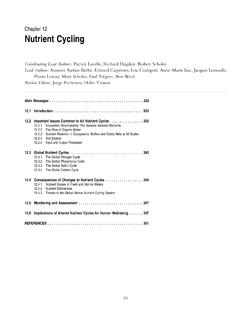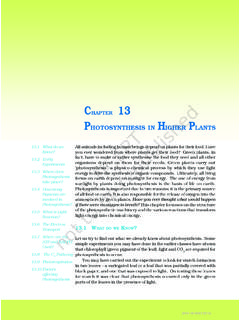Transcription of TRANSPORT OF IONS IN M - James Ziegler - SRIM & TRIM
1 8-1 8 - TRIM SETUP AND INPUT TRANSPORT OF ions IN MATTER TRIM is Monte Carlo computer program that calculates the interactions of energetic ions with amorphous targets. The specific science and mathematics behind the program were summarized in Chapter 7. This chapter reviews the use of TRIM to evaluate many different kinds of calculations. Most of this chapter may also be found in the Help menus included in the TRIM program. See also Chapter 9, TRIM Output Files, for an explanation of the various TRIM output plots and files. 8 - TRIM - 8-1 Introduction .. 8-2 TRIM Setup 8-2 Types of TRIM Calculation (Menu in upper-right corner) .. 8-3 Ion Distribution and Quick Calculation of Damage .. 8-3 Detailed Calculation with Full Damage 8-3 Monolayer Collision Steps .. 8-4 Calculation of Surface 8-4 Neutron / Electron / Photon Cascades .. 8-4 Various Ion Energy / Angle / 8-4 Special Multi-Layer Biological 8-4 Ion Name, Mass, Energy.
2 8-4 Target 8-6 Damage Energies of Target Atoms .. 8-6 Calculation Parameters .. 8-7 Viewing Window for Data and Plotting .. 8-7 Output Disk 8-8 Scientific Terms used in 8-9 Physics of Recoil 8-9 Physics of 8-10 The Stopping of ions in Compounds .. 8-11 Stopping Powers for ions in Gases .. 8-12 Special Applications of 8-13 Adding Multiple ions / Energies/Angles to Same Calculation .. 8-13 Using file to make Complex TRIM Calculations .. 8-14 Calculating Plasma ions Hitting a Solid ( ) .. 8-14 Simulating a Receding Surface from Sputtering ( ) .. 8-14 Simulating Reactor Radiation Damage in Metals ( ) .. 8-14 Radiation Damage from Neutrons/Electrons/Photons ( ).. 8-16 Special Setup for Multi-Layered Biological 8-18 How to Obtain 3-D plots of the Ion s Electronic Energy Loss .. 8-19 Note: This text is from Chapter 8 of the SRIM textbook (2008): SRIM The Stopping and Range of ions in Matter 8-2 How to use TRIM for Isotopically Enriched Targets.
3 8-20 Straggling in Ion Energy Reducers (Energy Degraders).. 8-20 Getting High-Resolution Collision Data from TRIM .. 8-22 Evaluating the Details of Ion Mixing Experiments .. 8-22 Using TRIM for Mixed Gas/Solid 8-22 Datafile of Complete Ion Trajectories through a Target .. 8-23 TRIM - Common Questions and 8-24 What are Projected Range and Radial Range Distributions ? .. 8-24 What is Straggling, Skewness and Kurtosis ?.. 8-25 What Causes Anomalous Peaks and Dips at Layer Edges ? .. 8-26 Running TRIM in Batch mode: 8-27 Changing TRIM Plot Colors ( ) .. 8-31 Changing The Maximum Size of Recoil Cascades ( ).. 8-31 Incorporating SRIM into Other Software (SRIM Module).. 8-32 Using "SR Module" to generate customized tables of Stopping and Range.. 8-33 Calculation Individual Atom-Atom Nuclear Stopping 8-34 Citations for Chapter 8-35 Introduction TRIM is a group of programs which calculate the stopping and range of ions (10 eV - 2 GeV/amu) into matter using a quantum mechanical treatment of ion-atom collisions (this manual refers to the moving atom as an "ion", and all target atoms as "atoms").
4 This calculation is made very efficient by the use of statistical algorithms which allow the ion to make jumps between calculated collisions and then averaging the collision results over the intervening gap. During the collisions, the ion and atom have a screened Coulomb collision, including exchange and correlation interactions between the overlapping electron shells. The ion has long range interactions creating electron excitations and plasmons within the target. These are described by including a description of the target's collective electronic structure and interatomic bond structure when the calculation is setup (tables of nominal values are supplied). The charge state of the ion within the target is described using the concept of effective charge, which includes a velocity dependent charge state and long range screening due to the collective electron sea of the target.
5 A full description of the calculation is found in Chapter 7. TRIM will accept complex targets made of compound materials with up to eight layers, each of different materials. It will calculate both the final 3D distribution of the ions and also all kinetic phenomena associated with the ion's energy loss: target damage, sputtering, ionization, and phonon production. All target atom cascades in the target can be followed in detail. The programs are made so they can be interrupted at any time, and then resumed later. Plots of the calculation may be saved, and displayed when needed. TRIM Setup Window TRIM is contained in the programs called SRIM (The Stopping and Range of ions in Matter). It can be accessed from its Title page by pressing the button marked TRIM. The easiest way to understand TRIM is to try one of the demonstration calculations. These have been selected to illustrate many of the variations available in TRIM.
6 In the Setup Window, Figure 8-1, see button: TRIM Demo. 8-3 The TRIM Tutorials are especially recommended to understand how to setup TRIM (see Chapter 11 and also ). These tutorials will explain in detail each of the required TRIM inputs. Figure 8-1 - TRIM Setup Window The TRIM Setup Window is used to input the data on the ion, target, and the type of TRIM calculation that is wanted. Almost all inputs have online explanations. To become familiar with the various types of calculations, it is easiest to use the TRIM Demo menu to see how various applications look in the Setup Window. Each of the entries above is discussed in this chapter. Types of TRIM Calculation (Menu in upper-right corner) Ion Distribution and Quick Calculation of Damage - This option should be used if you don t care about details of target damage or sputtering. The damage calculated with this option will be the quick statistical estimates based on the Kinchin-Pease formalism (see section Physics of Recoil Cascades for details about target damage).
7 The following data will be calculated correctly: Final distribution of ions in the target, Ionization energy loss by the ion into the target, Energy transferred to recoil atoms, Backscattered ions and Transmitted ions . You will get identical ion range results as when you use the Full Damage Cascade option below, since the random number generator for the ions is separate from that used for the recoils. This is useful to compare calculations. Detailed Calculation with Full Damage Cascades - This option follows every recoiling atom until its energy drops below the lowest displacement energy of any target atom. Hence all collisional damage to the target is analyzed. The one exception is for very rare massive cascades which exceed 20,000 atoms. At this point TRIM runs out of memory, and an error 8-4 message is posted indicating that the limit of 20,000 recoiling atoms in a single cascade has been exceeded.
8 The calculation continues after the message is posted. This error can be eliminated using the datafile: ..\Data\ See the later section in this chapter on Changing Maximum Size of Recoil Cascades ( ) Monolayer Collision Steps This calculation requires TRIM to make the ion have a collision in each monolayer of the target. This omits any use of the Free Flight Path, described in Chapter 7, and every collision will be calculated without any approximations. The results of using this option will ultimately give the same averaged quantities such as mean range, ionization, damage, etc., but the calculation will take far longer to execute. This type of calculation is essential for special applications such as sputtering (below) and to generate data on every possible collision in the file (see Chapter 9 for more details). Calculation of Surface Sputtering - This calculation requires TRIM to make the ion have a collision in each monolayer of the target, which is essential for an accurate calculation of ion sputtering.
9 Special plots are available to aid in understanding the special physics of sputtering. They allow you to analyze the effect of small variations on the Surface Binding Energy on the sputtering yield. This parameter is at the heart of sputtering, and its value is sometimes difficult to estimate. TRIM provides a table of Heat of Sublimation values, which are the normal starting values in estimating the surface binding energy of a target (see file ../Data/ATOMDATA). There is no significant difference in choosing this item over the previous selection above. (Details are found in the later section in this chapter called The Physics of Sputtering .) Neutron / Electron / Photon Cascades - This option is used to calculate only the damage cascades in a target. It uses as input the file which contains the kinetic information about atoms which start recoil cascades. The file is generated by some other program which calculates the energy transferred to target atoms by either neutrons, electrons or photons.
10 Then TRIM takes this external information and calculates the damage done to the target from recoil cascades. This is explained in the special TRIM application section "Radiation Damage from Neutrons / Electrons / Photons". If you select this option, you will get a sub-menu which requests which kind of damage calculation you wish to make. Various Ion Energy / Angle / Positions - This option allows the calculation of TRIM with ions starting at various energies, or with varying trajectory angles to the target surface, or starting at various depths in the target. There are a wide range of applications which require the ability to vary these ion parameters, and they are discussed in the section " ions starting with various Energy / Angle / Position". Typical are calculations of ions from a diffuse plasma, or for a target with a receding surface due to rapid sputtering, or reactor radiation damage to metals.
